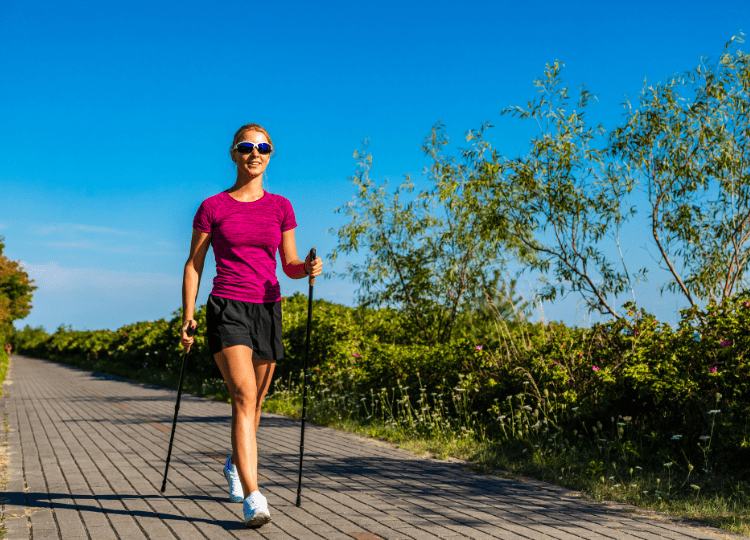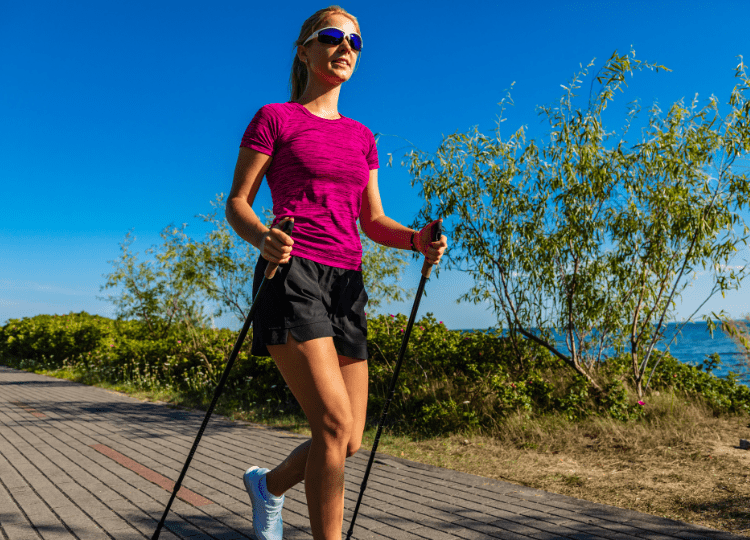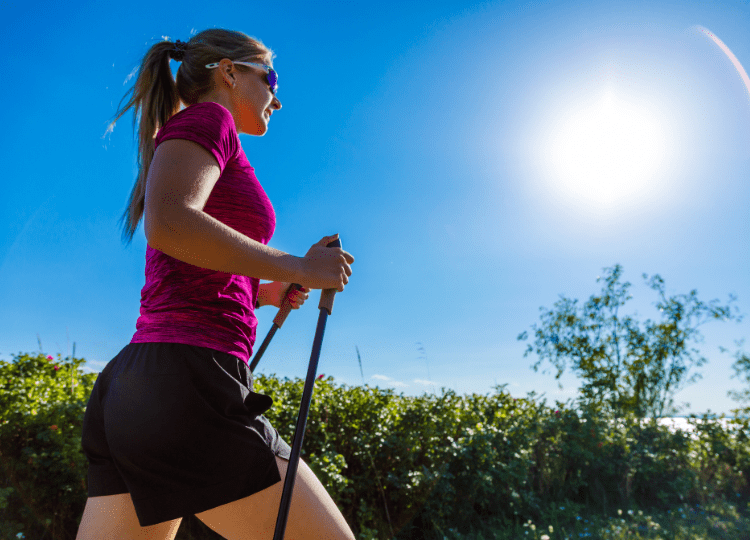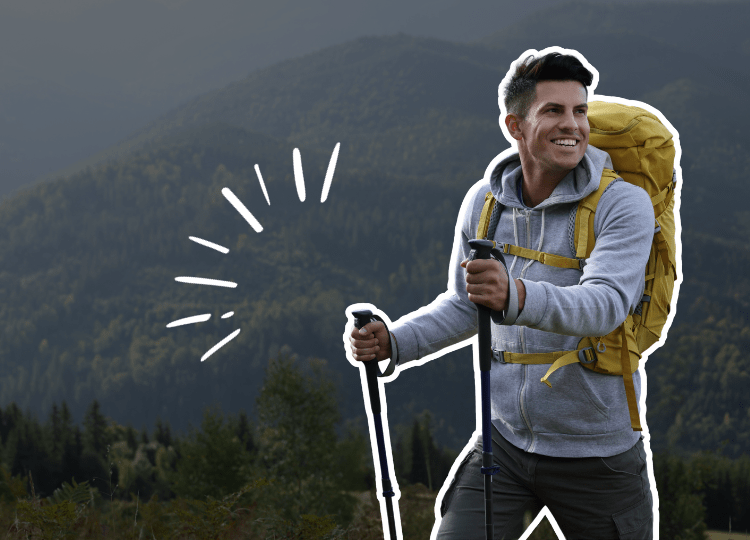Ever seen a group of individuals pacing briskly in the park, their arms swinging with poles that make them appear like eager mountaineers lost in the city?
That’s Nordic walking… a remarkable fusion of traditional walking and cross-country skiing… minus the snow.
Originating from the chilly landscapes of Finland, this fitness trend has rapidly blazed its trail across continents.
Nordic walking can bring a touch of adventure to your walks, as well as engaging more muscles and burning more calories.
So, let’s not pole-long this article any further… here’s your beginner’s guide to Nordic walking.

Quick Summary
- Nordic walking involves walking with poles (with a similar technique to cross country skiing).
- Compared to regular walking, it burns more calories and puts more focus on the upper body and core muscles.
- Nordic walking groups and tours can be a great way to keep fit and experience new places.
- Nordic walking poles are different from regular trekking poles.
What Actually is Nordic Walking?
Nordic walking, at its core, is an enhanced form of walking where you use specially designed poles to aid and intensify the experience.
Picture it as a blend between walking and cross-country skiing.
The technique was birthed in Finland in the 1930s when cross-country skiers started using poles during their off-season training. Fast forward to today, it’s evolved into a full-fledged fitness regime.
The action of the poles isn’t just to assist with balance. They serve a dual purpose… to distribute weight and, more importantly, to engage muscles that regular walking might not.
By actively pushing against them with each stride, you involve your upper body muscles, giving your arms, shoulders, and chest a workout as your legs and feet pound the pavement.

It’s not just for athletes or the adventurous. Whether you’re someone looking to amp up your daily exercise, an older adult wanting to maintain muscle tone without heavy weights, or someone rehabilitating from minor injuries, Nordic walking has perks for you.
And while we’re just scratching the surface here, the benefits of Nordic walking – which we’ll delve deeper into shortly – range from muscular to cardiovascular, potentially making your walks thrice as effective.
Nordic Walking Technique – How to Walk the Walk
Grip Those Poles
Slide your hands through the straps so the strap sits snugly against your palm. Grip the handle lightly, like you would a TV remote.
Set Your Stance
Stand up straight, feet hip-width apart. Place the poles at an angle behind you, so the tips of the poles touch the ground near your feet.
Walk the Walk
Start walking like you normally would. But here’s the twist: as your left foot steps forward, your right pole goes forward and touches the ground.
Then, as your right foot steps, your left pole goes forward. It’s a crisscross pattern, just like when you swing opposite arms and legs naturally while walking.
Push and Propel
After planting the pole, push it back so it propels you forward, and then lift the pole off the ground, swinging it forward for the next step.

Nordic Walking Equipment
Nordic Walking Poles
These aren’t your regular trekking poles. Designed specifically for Nordic walking, they’re typically made of lightweight materials like carbon or aluminium.
They come with ergonomic grips to comfortably fit your hand, and adjustable lengths to suit your height. The tips are versatile… sharp for soft terrains and rubber-padded for hard surfaces.
Nordic walking poles are typically shorter than regular trekking poles (we’ve included pole length recommendations in the FAQ section below).
A Buyer’s Guide to Nordic Walking Poles
Gloves
While they might seem like a mere accessory, Nordic walking gloves can be a game-changer. They offer better grip, especially during sweaty sessions, and also prevent blisters from prolonged pole usage.
Opt for ones that are breathable, snug, and preferably with moisture-wicking properties.
Footwear
While specialized Nordic walking shoes exist, they aren’t mandatory. What’s important is a comfortable pair that offers good arch support, cushioning, and grip.
Running or sturdy walking shoes usually tick these boxes.
If you’re exploring rugged terrains, consider lightweight hiking boots.
Clothing
It is best to wear lightweight clothing and include light gloves, a hat and a waterproof jacket for cold and wet weather.
In the summer, sun cream/block and sunglasses can be useful additions. It is better to wear several light layers of clothing rather than heavier, thicker clothing. It is also advisable not to wear something likely to flap at the sides of the body.
We have a whole guide dedicated to Nordic walking clothing recommendations too.
Accessories
While the poles are the main attraction, don’t forget some useful add-ons:
- Straps – Usually attached to the pole grips, they distribute pressure and reduce the strain on your wrists.
- Pole Tips – Depending on where you’re walking, you might want to switch between sharp tips for soft terrains (like grass or dirt) and rubber boot tips for harder surfaces (like pavement).
- Clip-on Lights – If you’re an early bird or a twilight trekker, these can be attached to your poles or clothing for visibility.
- Carrying Bag – For the globetrotters or those on-the-move, a bag designed to carry your Nordic poles can be super handy.
Nordic Walking Benefits
Burns More Calories Than Regular Walking
When you engage in Nordic walking, it’s like inviting more muscles to a calorie-burning party.
The use of poles, the extended stride, the push and pull… all these elements combine to ramp up the intensity.
It’s estimated that Nordic walking can burn up to 46% more calories than regular walking.
Picture this… if an average walk in the park feels like a gentle waltz, Nordic walking is your energetic jive, getting your heart rate up and those calories melting away faster.
Engages Upper Body and Core
Regular walking, as beneficial as it is, primarily targets the legs.
Enter Nordic walking, and suddenly, it’s a full-body symphony. The action of pushing against the poles not only engages your arms but also fires up your shoulders, chest, and – here’s the show-stealer – your core.
Every stride and pole push activates the abdominal muscles, making this a sneaky but effective core workout.

Social/Walking Groups
Let’s be real; everything’s more fun with friends. Nordic walking has spurred communities worldwide where enthusiasts form groups, making the fitness journey more social and enjoyable.
Sharing tips, setting group goals, or just revelling in the camaraderie, these groups turn exercise into an event.
If you’re someone who finds motivation in collective energy or loves the idea of making new pals while staying fit, Nordic walking offers a community vibe that’s hard to resist.
Reduces Pressure on Joints
For many, the idea of exercise is marred by the dread of joint pain or discomfort.
But here’s the beauty of Nordic walking… with the poles sharing some of the load, there’s a noticeable reduction in the pressure exerted on the knees, hips, and ankle joints. It’s like having a pair of supportive hands, gently guiding you along.
For those with mild joint concerns or individuals in the golden years seeking a gentler exercise form without compromising on intensity, Nordic walking might just be the golden ticket.
Nordic Walking FAQs
Do I need special shoes for Nordic walking?
Not necessarily. While you don’t need specialized shoes, it’s best to opt for a comfortable pair with good grip and support. Your regular walking or running shoes should do the trick!
How do I choose the right pole length?
A general rule: when you grip the pole with the tip on the ground, your elbow should be at a 90-degree angle. But when in doubt, consult with a retailer or instructor.
Can I do Nordic walking on any terrain?
Absolutely! While it’s commonly done on flat paths, you can take your Nordic walking adventure to grassy parks, trails, or even beaches. Just ensure the pole tips are suited for the terrain.
Is Nordic walking suitable for all ages?
Yes, indeed! From spirited teens to lively seniors, Nordic walking is adaptable and beneficial for all age groups. Just ensure you get the technique right to maximize benefits and minimize risks.
Bottom Line
Nordic walking, originating from Finland, elevates traditional walking with specialized poles, offering a full-body workout. This technique burns more calories, engages the upper body, and reduces joint pressure.
With the right equipment – from tailored poles and comfy footwear to supportive gloves – you’re set for an optimal experience.
Related Articles
11 Wild Swimming Benefits (and 3 Things to Consider)
